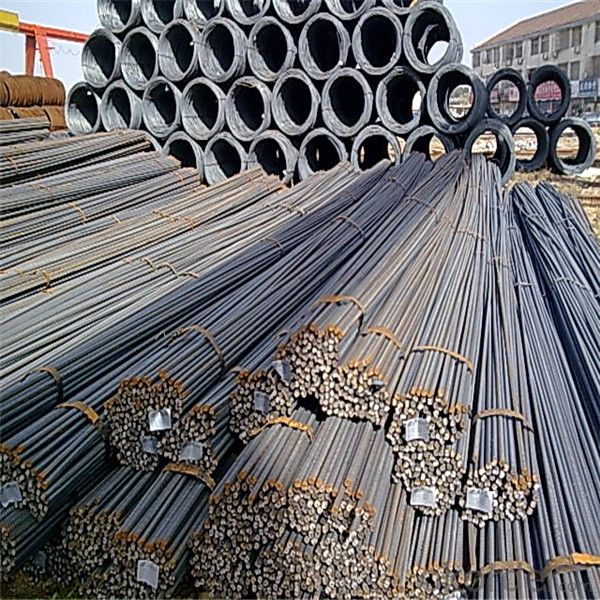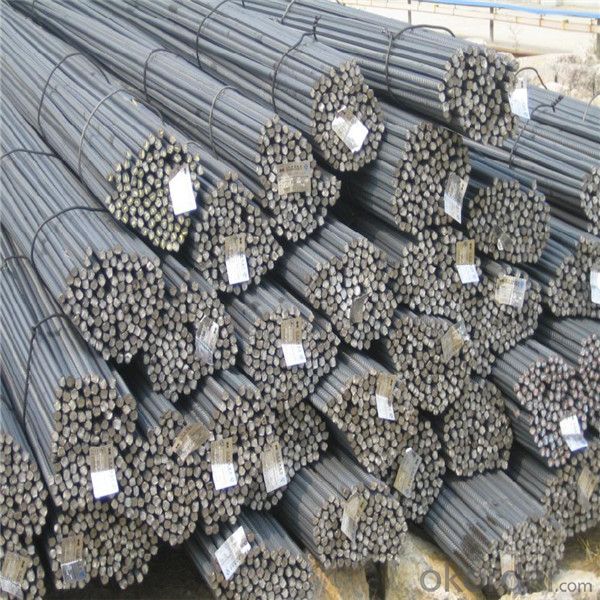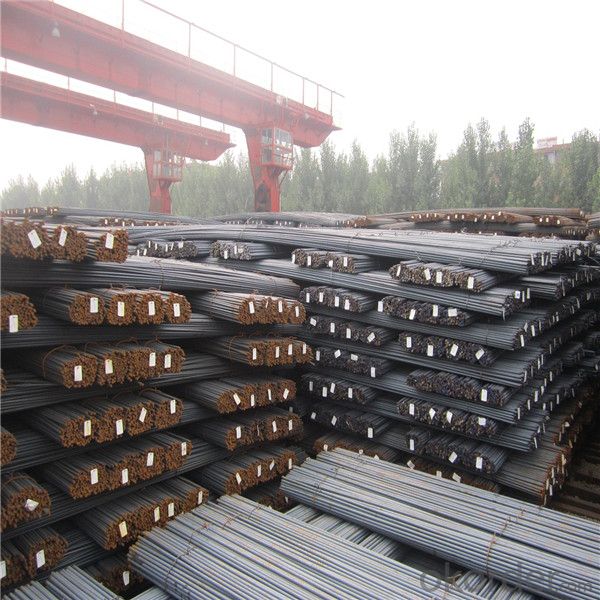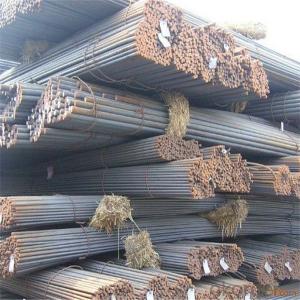Steel rebar 12mm 16mm for real estate constraction
- Loading Port:
- Tianjin
- Payment Terms:
- TT OR LC
- Min Order Qty:
- 100 m.t.
- Supply Capability:
- 18000 m.t./month
OKorder Service Pledge
OKorder Financial Service
You Might Also Like
Item specifice
Steel rebar is bars of steel commonly used in construction, especially for reinforcing concrete structures such as
driveways, foundations, walls, and columns. These bars come in different sizes and strength grades, and can be
smooth or may include deformations that provide greater adhesion for concrete poured over the bars. When used
in poured concrete, the bars are typically placed in a grid pattern, the concrete poured over them, and then readjusted
to maintain the proper shape while the concrete sets. Steel rebar can be purchased from a number of manufacturers
and is often found at construction retailers or large hardware stores.
Our Advantage: High quality steel products from 1 class mills in China
Reasonable price
Professionalism of the products
On-time delivery
Complete documents and certificates
Sincere service to meet our clients' requirements
Product Description :
Chemical composition (%): | Steel | C | Si | Mn | P | S | Ceq | ||||
HRB335 |
0.25 |
0.80 |
1.60 |
0.045 |
0.045 | 0.52 | |||||
HRB400 | 0.54 | ||||||||||
HRB500 | 0.55 | ||||||||||
Mechanical properties | Steel | Rel/ MPa | Rm/ MPa | A/ % | Agt/ % | ||||||
≥ | |||||||||||
HRB335 | 335 | 455 | 17 |
7.5 | |||||||
HRB400 | 400 | 540 | 16 | ||||||||
HRB500 | 500 | 630 | 15 | ||||||||
Package: | Standard export packing or as customer's request | ||||||||||
Application: | Construction, building, bridge, road. ect | ||||||||||
Payment terms | 1).100% irrevocable L/C at sight. | ||||||||||
Delivery time | 15-30 days after receipt of L/C or deposit by T/T | ||||||||||


Packing:
In bundles, each bundle weight 3.5 tons. Load by container or by bulk verssel.


Our service
(1) We cooperate with famous factories with advanced equipment and well trained workers.
(2) We can provide factory price with trading company service.
(3) We continuously work on the improvement of our processes, guaranteeing consistently high standards
of quality to keep none compensation.
(4) We guarantee 24 hours response and 48 hours solution providing service.
(5) We accept small order quantity before formal cooperation.
(6) We deliver the agreed quality at the agreed time, reacting to changes in customer wishes in a flexible way.
(7) Due to our volume and selling power, we have excellent freight rates with shipping lines.
(8) We strive to always be fair and honest in our dealings with customers.
(9) We strive to work together with customers to achieve much more than we can achieve alone.
(10) Through our passion and commitment we aim to be a market leader in all our key markets. To maintain
our position as market leader we must continue to add value in all that we do.
FAQ:
1.Q: What's your MOQ(minimum order quantity)?
A: One full container, mixed acceptable .
2. Q: What's your packing methods?
A: Packed in bundle or bulk ..
3. Q: How can I buy CNBM products in my country?
A:Please send us an inquiry or email ,we will reply to you if there is distributor in your country
4. Q: Can we visit your factory?
A: Warmly welcome. Once we have your schedule, we will arrange the professional sales team to follow up your case.
5. Q: How long does it take to get the product if i place an order?
A:With the process of your requirements,we will pack and deliver in 3-7 days. If it is by sea shipment,it will take 15-45 days depending on different locations
- Q:What is the process of pre-stressing steel rebars?
- The process of pre-stressing steel rebars involves applying a predetermined amount of stress or force to the rebars before they are subjected to loading. This technique is commonly used in the construction industry to improve the structural strength and durability of concrete structures. The process typically starts with the selection of high-strength steel rebars that have good tensile strength properties. These rebars are usually made from carbon steel or alloy steel and come in various sizes and shapes, depending on the specific application. Once the rebars are selected, they are cleaned and coated with a protective layer to prevent corrosion. After that, the rebars are placed into the desired position within the concrete structure, such as beams, columns, or slabs, according to the design specifications. Next, the pre-stressing process begins. There are two primary methods for pre-stressing steel rebars: pre-tensioning and post-tensioning. In pre-tensioning, the rebars are initially tensioned by fixing them to an anchorage point or a strong frame. The opposite end of the rebars is then pulled using hydraulic jacks or mechanical devices, applying a significant amount of force. Once the desired stress is achieved, the rebars are secured in their stressed position by casting concrete around them. After the concrete has hardened, the jacks or devices are released, transferring the stress to the rebars. In post-tensioning, the rebars are first placed into the concrete structure without any initial tension. After the concrete has hardened, a series of ducts or channels are created within the structure, running along the path of the rebars. High-strength steel strands or cables are then inserted through these ducts. The strands are anchored at one end of the structure and tensioned using hydraulic jacks or similar devices. This tensioning process applies a force to the rebars, which is transferred to the concrete, compressing it. Once the desired stress is achieved, the strands are secured and the ducts are filled with grout or mortar to protect them from corrosion. Both pre-tensioning and post-tensioning techniques result in pre-stressed steel rebars that provide several benefits to concrete structures. These include increased load-carrying capacity, improved resistance to cracking and deformation, enhanced durability, and overall better structural performance. The process of pre-stressing steel rebars is a vital aspect of modern construction practices, ensuring the longevity and safety of various types of concrete structures.
- Q:How do steel rebars improve the durability of concrete structures?
- Steel rebars improve the durability of concrete structures in several ways. Firstly, steel rebars act as reinforcement in concrete, providing added strength and stability to the structure. When combined with concrete, the high tensile strength of steel rebars helps to resist cracking and prevent the structure from collapsing under heavy loads or seismic activities. Secondly, steel rebars help to control the formation and propagation of cracks in concrete structures. Concrete is strong in compression but weak in tension, meaning it tends to crack when subjected to tensile forces. By placing steel rebars strategically within the concrete, these cracks are minimized and prevented from spreading, thus enhancing the overall durability of the structure. Furthermore, steel rebars help to improve the resistance of concrete structures against corrosion. Concrete is highly alkaline, which forms a protective layer around the steel rebars, preventing them from rusting. This corrosion resistance ensures that the rebars maintain their structural integrity over time, reducing the risk of deterioration and enhancing the longevity of the concrete structure. In addition, steel rebars also enhance the fire resistance of concrete structures. Due to their high melting point, steel rebars can withstand high temperatures, thereby preventing the concrete from losing its structural integrity during a fire. This added fire resistance ensures that the concrete structure remains stable and safe in the event of a fire, further enhancing its durability. Overall, the inclusion of steel rebars in concrete structures significantly improves their durability by providing added strength, controlling cracks, enhancing corrosion resistance, and increasing fire resistance. These benefits contribute to the longevity and safety of concrete structures, making them more reliable and sustainable in the long run.
- Q:What are the different types of steel rebars used in road bridges?
- There are primarily two types of steel rebars commonly used in road bridges: carbon steel rebars and stainless steel rebars. Carbon steel rebars are the most widely used and cost-effective option, known for their strength and durability. On the other hand, stainless steel rebars are corrosion-resistant, making them suitable for bridges exposed to harsh environmental conditions or those built near bodies of water. Each type of rebar has its own advantages and is selected based on the specific requirements and conditions of the bridge project.
- Q:How do steel rebars affect the overall thermal expansion of concrete structures?
- The overall thermal expansion of concrete structures can be significantly influenced by steel rebars. Concrete exhibits a comparatively low coefficient of thermal expansion, resulting in less expansion and contraction when exposed to temperature changes in comparison to other materials. Conversely, steel rebars possess a higher coefficient of thermal expansion than concrete. When temperature fluctuations occur, such as during hot or cold weather, the expansion or contraction rates of the steel rebars differ from those of the surrounding concrete. This disparity in thermal expansion rates can generate internal stresses within the concrete structure. If not adequately addressed, these internal stresses may lead to cracking or even structural failures. In order to mitigate the effects of thermal expansion, engineers incorporate appropriate reinforcement, including steel rebars, into the design of concrete structures. The presence of rebars aids in distributing the stresses resulting from temperature changes more evenly, thereby reducing the likelihood of cracking or damage. Furthermore, the tensile strength of steel rebars enables them to withstand the forces produced by the differential expansion, ensuring stability for the overall structure. Nevertheless, it is essential to recognize that the effects of thermal expansion cannot be completely eliminated solely by steel rebars. Other factors, such as the inclusion of expansion joints in the design and the utilization of proper construction techniques, also play a crucial role in minimizing the impact of temperature fluctuations on concrete structures.
- Q:What are the advantages of using ribbed steel rebars?
- There are several advantages to using ribbed steel rebars. Firstly, the ribs on the surface of the rebar provide enhanced bond strength with the concrete, ensuring better load transfer and reduced slippage between the two materials. This results in improved structural integrity and increased resistance to cracking and deformation. Additionally, the ribbed texture also enhances the rebar's ability to withstand seismic forces, making it an ideal choice for earthquake-prone regions. Moreover, the increased surface area of the ribs allows for better corrosion resistance, extending the lifespan of the rebar and minimizing maintenance costs. Overall, ribbed steel rebars offer superior performance, durability, and safety in reinforcing concrete structures.
- Q:How are steel rebars measured?
- The standardized system known as the "bar size number" is utilized to measure steel rebars. Each rebar size is assigned a numerical value, which corresponds to its diameter. The diameter is measured in inches or millimeters, depending on the region or country. In the United States, the bar size number ranges from #3 to #18 and indicates the diameter in eighths of an inch. For example, a #3 rebar has a diameter of 3/8 inch, while a #8 rebar has a diameter of 1 inch. Beyond #8, the diameter is measured in quarters of an inch. A #11 rebar, for instance, has a diameter of 1 1/8 inches, and a #18 rebar has a diameter of 2 1/4 inches. In metric countries, millimeters are used to measure rebars. The diameter is usually rounded to the nearest millimeter. For instance, a 10 mm rebar is equivalent to a #3 rebar in the US, and a 25 mm rebar is equivalent to a #8 rebar. To determine the length of a rebar, a tape measure or ruler is employed. The length is typically measured in feet or meters. Rebars are commonly available in 20 or 40 feet (6 or 12 meters) lengths, but they can also be cut to custom lengths as per project requirements. It is important to note that the measurement system may vary slightly in different regions or countries. Therefore, it is crucial to consult local standards and codes for accurate measurement guidelines.
- Q:Can steel rebars be used for both residential and commercial construction?
- Steel rebars can serve for both residential and commercial construction purposes. They are widely employed as reinforcement in concrete structures to enhance their robustness and stability. Steel rebars are suitable for diverse construction endeavors such as residential buildings, commercial establishments, bridges, and infrastructure projects. By incorporating steel rebars, the concrete structure becomes capable of withstanding considerable loads, seismic activity, and other external forces. Regardless of whether it is a modest residential dwelling or a substantial commercial complex, steel rebars are a dependable and extensively utilized material for reinforcing concrete structures in both residential and commercial construction settings.
- Q:How are steel rebars cut to size on construction sites?
- Steel rebars are typically cut to size on construction sites using specialized tools such as portable hydraulic or electric rebar cutters. These tools have sharp blades that can easily slice through the steel bars, ensuring precise and accurate cuts. The rebars are measured and marked beforehand, and then the cutters are used to trim them to the required lengths. This process allows for efficient and convenient customization of rebars to fit specific construction needs.
- Q:Can steel rebars be used in tunnels or underground mines?
- Tunnels or underground mines can indeed utilize steel rebars. These strong bars are frequently employed in construction endeavors to fortify concrete structures, and the case is no different for tunnels and underground mines. The inclusion of reinforcing steel bars enhances the potency and steadiness of the concrete utilized in tunnel linings or mine shafts. By resisting the pressures exerted by the adjacent soil or rock, these bars avert cracking or collapse, thereby augmenting the overall robustness and endurance of the edifice. The selection of steel rebars is contingent upon their individual attributes, such as diameter, grade, and resistance to corrosion. This ensures that they meet the design prerequisites and are suitable for the specific subterranean circumstances.
- Q:What are the recommended practices for welding steel rebars?
- The recommended practices for welding steel rebars include ensuring proper surface preparation to remove any contaminants, selecting the appropriate welding process (such as shielded metal arc welding or gas metal arc welding), using the correct electrode or filler material, maintaining the appropriate welding parameters (current, voltage, travel speed), and performing regular inspections to ensure the quality and integrity of the welds. It is also important to follow safety guidelines, such as wearing appropriate protective equipment and working in a well-ventilated area.
1. Manufacturer Overview |
|
|---|---|
| Location | |
| Year Established | |
| Annual Output Value | |
| Main Markets | |
| Company Certifications | |
2. Manufacturer Certificates |
|
|---|---|
| a) Certification Name | |
| Range | |
| Reference | |
| Validity Period | |
3. Manufacturer Capability |
|
|---|---|
| a)Trade Capacity | |
| Nearest Port | |
| Export Percentage | |
| No.of Employees in Trade Department | |
| Language Spoken: | |
| b)Factory Information | |
| Factory Size: | |
| No. of Production Lines | |
| Contract Manufacturing | |
| Product Price Range | |
Send your message to us
Steel rebar 12mm 16mm for real estate constraction
- Loading Port:
- Tianjin
- Payment Terms:
- TT OR LC
- Min Order Qty:
- 100 m.t.
- Supply Capability:
- 18000 m.t./month
OKorder Service Pledge
OKorder Financial Service
Similar products
New products
Hot products
Hot Searches
Related keywords




























